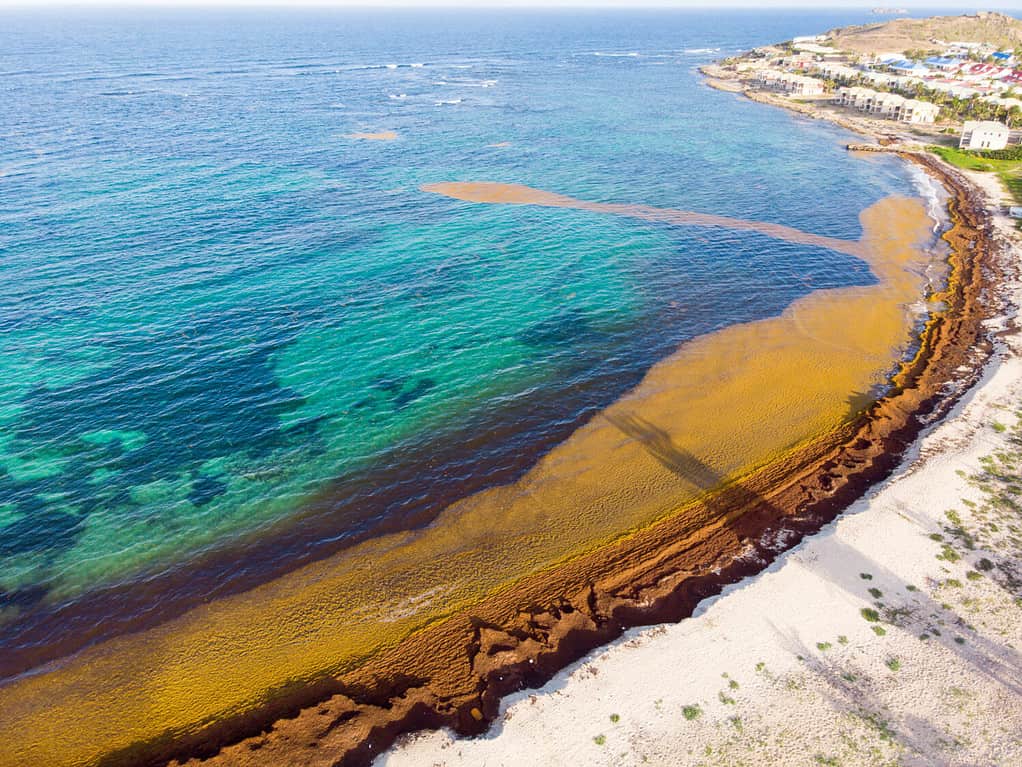Florida’s beaches are often exceptionally beautiful. However, seaweed can occasionally wash ashore and disrupt swimming and other beach activities. It’s hard to swim or enjoy the beach when seaweed levels peak.
However, seaweed in Florida is not straightforward. There are many types of seaweed in Florida, and the peak season can differ depending on the type.
Types of Seaweed in Florida

There are
tonsof seaweed species found in Florida, and these all grow slightly differently.
©Damsea/Shutterstock.com
There are three main types of seaweed in Florida: Sargassum, Caulerpa taxifolia, Laurencia, and Udotea filiformis. Let’s take a look at each in turn.
1. Sargassum
Sargassum is a brown seaweed that forms in the Sargasso Sea. However, large mats often drift ashore in Florida, specifically on the east coast. It provides a habitat for marine life and is an important part of the ecosystem.
However, large influxes can have a negative impact on humans. This seaweed can emit a rotten egg odor and hinder beach enjoyment.
Typically, large influxes peak in spring and summer. That said, it isn’t truly predictable. There isn’t a specific day or month that this seaweed will show up. A lot depends on ocean conditions and nutrient availability.
2. Caulerpa taxifolia
This seaweed is green and invasive. It can smother native seagrasses and disrupt local ecosystems. This seaweed is around all year but often isn’t terribly disruptive. It tends to spread rapidly when warmer, so the “peak” season would technically be in the summer.
3. Laurencia
This red seaweed is native to Florida and forms mostly in shallow water. It offers food and shelter for many marine creatures, though it can be sensitive to changes in water chemistry and invasive species.
This seaweed doesn’t truly have a peak season. It is present year-round and doesn’t typically grow unchecked.
4. Udotea filiformis
This green seaweed is most commonly called “stonewart.” It has more structure than most seaweed, providing a habitat for fish and other sea creatures. Like Laurencia seaweed, this species doesn’t tend to peak during a specific time of the year. Instead, they are present throughout the year and don’t tend to grow uncontrollably.
Impacts on the Beach

Seaweed can accumulate on beaches, making it challenging to enjoy the beach or swim.
©Multiverse/Shutterstock.com
While seaweed can make beach-going a bit more complicated, it isn’t all bad. Seaweed provides shelter and food for many animals, and it is necessary for a healthy ecosystem. Therefore, removing seaweed as a whole isn’t recommended or even possible. It even helps stabilize shorelines and reduce erosion, which is important with Florida’s shifting sealine.
However, excessive seaweed accumulation can also be negative. It can be unsightly and smelly, making hanging out on the beach less enjoyable. Swimming may also be impossible during serious seaweed accumulation.
Swimming in seaweed just isn’t enjoyable! Plus, seaweed can hide small, potentially dangerous sea animals like jellyfish. Swimming in seaweed isn’t recommended for this reason.
Decomposing seaweed releases hydrogen sulfide, which makes it smell like rotten eggs. In severe cases, this chemical may irritate your eyes and airways. It may even be a more serious problem for more sensitive individuals.
Of course, invasive seaweed is a significant problem. It can push out native species and disrupt the ecosystem. Currently, invasive species aren’t prolific enough to cause problems with beach activities and swimming. However, it isn’t kept in check like native species, and there is a chance it could become more prolific in the future.
Predicting Seaweed Blooms

In the water, seaweed provides a much-needed habitat for small ocean animals.
©Andriy Nekrasov/Shutterstock.com
While Florida isn’t always hit by massive seaweed blobs, future blooms are always possible. Seaweed is constantly growing and shrinking as the ocean conditions change. If a large mat develops and breaks away, there isn’t any promise that it will end up in Florida.
Experts monitor seaweed growth and may be able to predict seaweed problems a little in advance. However, it is currently impossible to know when exactly seaweed will impact Florida more than a week or so ahead of time.
Peak season is also exceptionally long, so there isn’t even a month when seaweed tends to be the worst. Instead, you’re looking at about half the year. Seaweed tends to grow most when it is warm, though seaweed blobs have hit Florida in the cooler months.
Seaweed blobs are still extremely difficult to predict. Don’t expect very accurate predictions more than a few days ahead of time.
What Beaches in Florida Have Seaweed?
All beaches in Florida can potentially have seaweed. No beach is safe from seaweed all the time. There also aren’t many areas less likely to get seaweed blobs. Therefore, you can’t change your vacation area in the hopes that there won’t be seaweed there.
All beaches are more prone to seaweed in the warmer months, too.
The photo featured at the top of this post is © inusuke/iStock via Getty Images
Thank you for reading! Have some feedback for us? Contact the AZ Animals editorial team.







